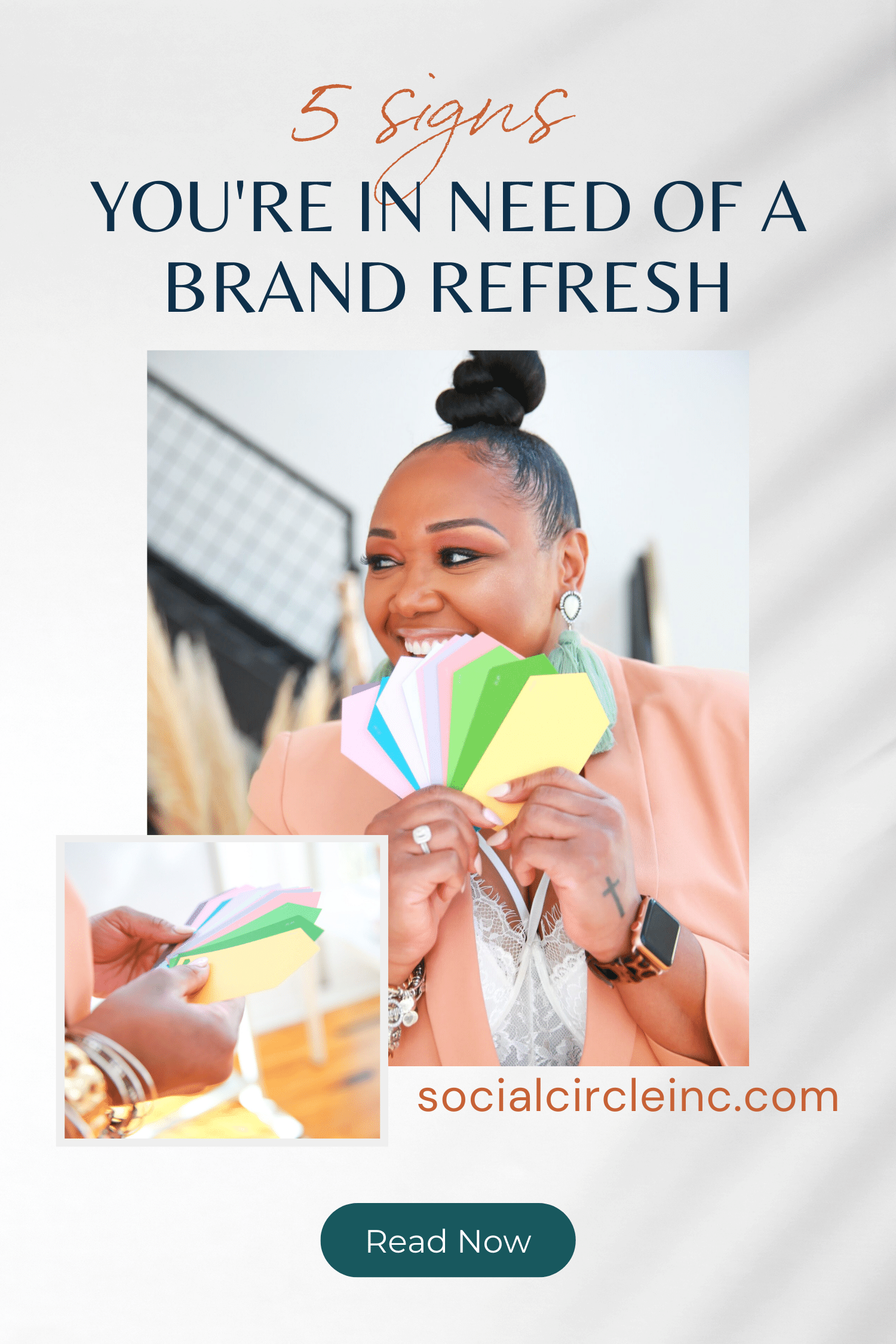I see it all the time…
You fall in love with a pretty color scheme, typography set, or website and immediately decide that this is what you want your brand to look like. So you immediately jump into action and create it. And you’re happy for a little while. However as the newness wears off, you find yourself eyeing other gorgeous brands and websites, and start feeling like another rebrand is in order.
Sound familiar?
If so, read on to discover 5 not-so-obvious signs you may be in need of a brand refresh:
Before we get started, let’s discuss exactly what a brand refresh is. Although the terms brand refresh and rebrand are often used interchangeably, there’s actually a big difference between the two.
A brand refresh is like a mini-makeover for your brand: a new brand logo, a new color story, a new tag line. And maybe just one of these, not all. The brand logo is crucial as it reflects the company’s mission and values. However, a rebrand means you’re overhauling the whole works. A brand redesign involves making major changes to your target audience and ideal client, and/or your brand’s personality, message, values, and tone. You may be changing the name of the business too.
Here are 5 Signs You’re in a Need of a Brand Refresh:
1. You think your brand identity consists of a logo.
If you think your branding consists of purchasing a log on Etsy with your favorite logo, then we need to talk! While a brand’s logo is an incredibly important part of your branding – it’s only one part. The emotional connection customers have with a brand’s logo is significant, as it communicates the brand’s essence and values. So what exactly is a brand? Your brand’s identity is the promise you make to your customers about quality, service, experience, etc.
Think of your brand as your business’s reputation – what the consumer thinks about your business and what distinguishes your business from your competitors. Your brand is your business idea and your branding is the visual used to communicate that idea. Therefore, your branding encompasses your logo, color palette, fonts, patterns, brand voice, core values as well as your core audience and customer experience.
One of the most common branding mistakes new entrepreneurs make is designing their logo prior to defining the attributes previously discussed. While the logo is an integral part of the brand – the logo should actually reflect your brand voice, core values and appeal to your target audience. If you design your logo prior to completing this process, you will likely struggle with how best to communicate your brand voice and values visually.
This often leads to having a logo that feels out of sync with your business and ultimately doesn’t appeal to your core audience. That’s why when we work with clients, our first step in the process involves an intensive brand clarity call to make sure your brand voice, core values, and core audience are well defined prior to starting any design work. In order to get a strong brand identity, we need to make sure we have the foundation of your business/personal brand.
2. You switch up your fonts and colors like it’s Fashion Week.
If you’re constantly switching up your fonts and colors that’s a good indication that (1) your branding is not working for you or (2) you suffer from severe design envy. Either way, it’s probably safe to say that you’re branding is not working for you. While it’s nice to experiment with different color palettes and fonts, it’s important to evaluate your existing brand performance and keep your overall brand cohesive by following clear brand guidelines.
When you think of some of the most successful brands in the world such as Nike, Apple, and Burberry, you’ll quickly notice that they all have certain colors, symbols, or fonts that they typically use to distinguish their brand. While your business may not be a household name, it’s important to create a strong cohesive brand. This is what ultimately builds trust with your clients and customers and makes them feel comfortable investing in your products and services.
Related Post: How to Choose the Right Fonts for Your Brand
Related Post: How to Choose Your Brand Colors
3. Your photos suck.
Sorry to be blunt, but if you haven’t invested in professional photography and taken the time to curate high-quality stock photos your branding is significantly lacking. Whether you go the photographer route, invest in high quality stock photography or go the DIY route, high quality photos will instantly make your website look credible and professional. Photos are also a great tool for conveying your brand story and creating a connection with your core audience. The most successful brands know how to use photography to tell a story.

Related Post: How to Prepare for Your Brand Photo Shoot
4. You don’t have brand guidelines or brand rules.
The best way to figure out which types of images, colors, and fonts to use is to create a brand mood board. You can create a physical brand mood board at home by pinning color swatches, patterns, and images to a bulletin board or use a digital website or tool like Adobe XD or Canva to create your mood board. Once you’ve completed your mood board it’s a good idea to get insight from potential clients and colors to see if there are specific colors of fonts that resonate with them.
Once your brand mood board is completed you can create your brand style guide. Your brand style guide outlines, colors, fonts, logos, voice, etc and how they should all be used or not used depending on the situation. Your brand style guide can be used to inform your brand photography session, source stock images, and ultimately design your website and additional marketing materials and brand collateral.
Unlock the Branding Strategies of Billion Dollar Brands: Free Brand Strategy Course
Discover the exact process we use to craft breakthrough brands for our clients. Gain valuable insights from our founder, who has extensive experience working with industry giants like Nike, Disney, Hoka, and Coach.
5. You’re not sure if your brand resonates with your audience.
Another way to tell if you’re in need of a brand refresh is to survey your audience. If you already have clients and customers this can be done by emailing a segment of your list and asking for feedback. If you’re designing a brand for a new business Facebook groups are another great way to get feedback from your core audience.
You may notice that I did not say get feedback from friends and family. This is because many of your friends and family are often too close or have too much distance from your project to provide valuable feedback. When curating feedback, it’s important to survey potential or previous customers to get the most insight for your brand image and brand refresh. Analyzing brand sentiment through social listening, customer feedback, and marketing reviews helps identify areas for improvement and ensures that your rebranding strategy aligns with customer perceptions.
Summary
No matter what industry you are in, you need to build a strong brand that goes beyond looks and instead focuses on the values that you can bring to your audience. Whether your design is outdated, your online and offline branding don’t exactly align, your vision lacks clarity, your brand reputation is suffering, or your growth has flatlined, establishing a new brand may be in order. This involves developing new brand stories, guidelines, and visual elements to create a cohesive identity that reflects your company’s values and mission, enhancing market visibility and fostering consumer trust.
FAQ’s:
What is the difference between a brand refresh and a rebrand?
A brand refresh involves minor updates like a new logo or color scheme, while a rebrand is a complete overhaul, including changes to the brand’s identity, target audience, and messaging.
How do I know if my brand identity is weak?
If you believe your brand identity is just a logo, or if your logo doesn’t align with your brand’s values and audience, your brand identity may need strengthening.
Why is consistent branding important?
Consistent branding builds trust and recognition with your audience. Frequently changing fonts and colors can confuse customers and weaken your brand.
What are brand guidelines, and why do I need them?
Brand guidelines define how your brand elements like colors, fonts, and logos should be used. They help maintain consistency and cohesiveness across all brand materials.
How can I tell if my brand resonates with my audience?
You can survey your current audience or potential customers to gather feedback. If your brand doesn’t connect well, a refresh or redesign might be necessary.

